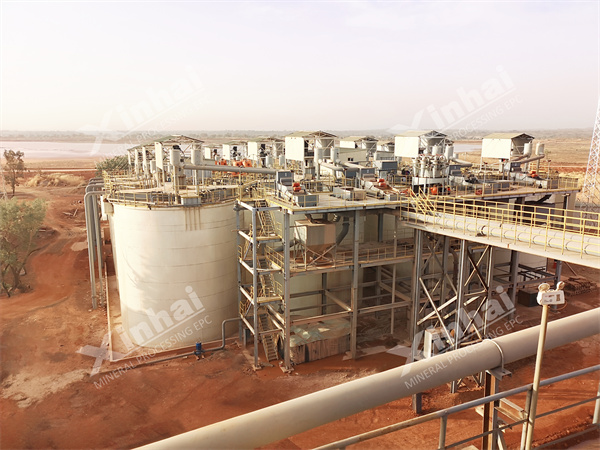Carbon-in-liquidation gold extraction has a wide range of applications, simple process flow, high gold recovery rate, and less environmental impact. However, many gold mining plants are still using traditional heap leaching to recover gold. The gold recovery rate of many plants can only reach 50-60%, resulting in many useful minerals in the tailings that have not been effectively recovered and utilized, which is a waste of resources. I will compare carbon-in-liquidation gold extraction with heap leaching gold extraction.

1.1. Advantages of carbon-based leaching
(1) Strong adaptability
The carbon-based leaching process has strong adaptability to gold extraction. It can achieve good technical and economic indicators for muddy oxidized ores (whose filtration and sedimentation performance is poor), ores with high copper, arsenic, antimony and other high carbon content.
(2) Simple process
The carbon-based leaching process is simple, with low investment, low cost and small footprint.
(3) High gold recovery rate
The carbon-based leaching process has a high gold recovery rate. It can achieve a high recovery rate (generally above 90%~93%) for gold ores with high clay fine mud and fine grains.
(4) Good environmental benefits
Since the solution is recycled in the carbon-based leaching process, there is less discharge, and the cyanide content in the discharged tail liquid is relatively low, the treatment cost is low and the environmental benefits are good.
Of course, carbon-based leaching also has some disadvantages, that is, it requires the use of high-quality activated carbon that is wear-resistant, hard and of appropriate particle size in the adsorption operation. In addition, carbon-based leaching is not suitable for treating gold ores with high silver content.
1.2. Advantages of heap leaching
(1) Simple process and low cost
The process flow of heap leaching is relatively simple and requires less equipment, so the infrastructure investment and production cost are low. The production cost of heap leaching is low, about 40% of the conventional method, and the production and construction period is short. Generally, it can be completed and put into production in four to six months.
(2) Suitable for large-scale production
Heap leaching is suitable for processing large-scale low-grade ores and can process ore piles of hundreds of thousands to hundreds of millions of tons.
The disadvantages of heap leaching are also quite obvious. First, it may have an impact on the environment during the production process, including soil, water bodies and vegetation. In addition, the recovery rate of heap leaching is relatively low, which may cause waste of resources.

Take a gold mine in Sichuan as an example. The ore type of the deposit is mainly replaced (silicified) quartzite gold ore. The occurrence state of gold in the ore is mainly microscopic and ultramicroscopic gold. The gold-bearing minerals are mainly arsenopyrite, pyrite, stibnite and limonite. The ore contains high levels of As and Sb (the highest content is 1.37% As and 0.057% Sb).
(1) Heap leaching method
When the heap leaching method is used for development, the annual ore processing volume is 10,000 tons, the average Au grade of the ore entering the heap is 5.6g/t, the particle size of the ore entering the heap is less than 30mm (of which 60% is ≤20mm), the average Au leaching rate is 55%, the average gold-bearing carbon adsorption rate is 94%, and the actual Au recovery rate of the ore heap leaching is less than 50%. Due to the low leaching rate of the gold ore, the average Au grade of the heap leaching tailings is about 2.5g/t.
(2) Carbon-in-place leaching
Due to the low recovery rate and high gold content in the tailings, the concentrator studied the material composition of the mine and conducted a carbon-in-place leaching test on the gold ore of the mine. The test results showed that when the grinding fineness of 200 mesh accounted for 96%, the leaching rate was 88%, and the average Au grade of the tailings was about 0.67g/t. Since the heap leaching plant had been built and put into production at that time, the carbon-in-place leaching plant design was not adopted.
Now, according to a comparative analysis, if the carbon-in-place leaching method was adopted at that time, the output value could be increased by 24.9 million yuan based on a recovery rate of 83%. The concentrator also conducted a variety of recovery test studies on the tailings (containing Au 0.25g/t), but there was no economically reasonable solution. If the carbon-in-place leaching method is used again, it will be a loss. There was no resource economic awareness in resource development at the beginning, which resulted in the serious waste of precious gold resources in the mine. The lesson is very profound.
Through the comparison of the two gold extraction methods above, we can draw the following conclusions: Although the investment cost and operating cost of heap leaching are relatively low, the recovery rate is not high, and the final economic benefits may not be very good. Although the initial investment cost of carbon leaching is relatively low, the recovery rate is high, and it can provide better economic returns in the long run. Moreover, from the perspective of resource utilization, it is better to choose carbon leaching to avoid resource waste.